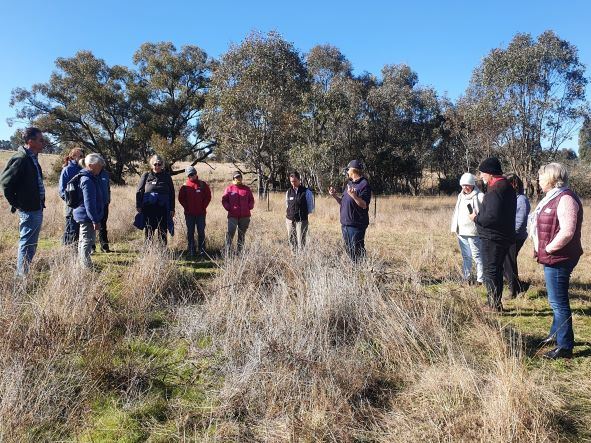This is a summary of a webinar and paddock walk held in June 2022.
The webinar was recorded on Thursday 17 June 2022. During the webinar we discussed managing blackberries in creeks and gullies with Lori Gould from the Australian River Restoration Centre and small farmer Christine Aughey.
The topics discussed in the webinar include blackberry control options, managing a weed control project and where to start, preventing erosion after the weeds are removed, fencing and revegetation.
Watch the webinar

After the webinar a group of farmers visited a small farm just outside of Yass for a paddock walk to discuss blackberry management. These are the take away messages from the event.
1. The focus of weed management has shifted from eradication to asset protection and containment. Some weeds like blackberry are known as transformer weeds. Transformer weeds have a high impact on native plant communities and degraded landscapes by transforming ecosystem processes and functioning. Transformer weeds use their competitive advantage to develop monocultures by modifying the soil and conditions to their preferred niche. They are also able to recruit seedlings easily, often using a number of different methods. Through these processes transformer weeds change the surrounding environment to favour their spread. Blackberry plants for example are able to spread using seed, seedlings from their roots (that can extend for 4 meters from the plant) and by growing from the tips of branches when they touch the ground.
2. Weeds like blackberry are opportunistic and will colonise bare soil and eroded slopes. Lori recommends keeping ground cover above 80% so there is no space for weeds to germinate. Some weeds are considered pioneer plants, modifying the soil and habitat conditions so other plants can establish once they have completed their lifecycle. Some examples may include cape weed and Patterson’s Curse.
3. The native raspberry Rubus parvifolius, looks similar to the introduced blackberry Rubus fruticosus. Native raspberry has a different leaf shape to blackberry and is red on the outer leaf margin, the veins are also more pronounced. Blackberry has nine different species in NSW.
4. Wetting agents used with herbicides are not approved for use along waterways, Glyphosate is the only approved herbicide for blackberry control in waterways. You can apply for an off-label permit for other herbicides through the Australian Pesticides and Veterinary Medicines Authority (APVMA). Lori recommends that you only spray actively growing plants, just before or while they are fruiting. Care must be taken when spraying in waterways, if you are unsure of how to do it seek professional advice. In some cases the paint and brush method may be a more targeted approach.
5. Lori suggests you aim to control 30% of the weed infestation/year. By using a staged approach you can replant the affected areas and leave some habitat for woodland birds until you can get the infestation under control.
Resources
Rivers of Carbon Blackberry Guide
Mt Lofty Rangers video - on how to differentiate blackberry and native raspberry
Maintaining ground cover for water infiltration - Local Land Services
Goat webinar (includes information on how to use goats to control weeds)
Herds for Hire
NSW DPI Weed Wise
Victorian blackberry control taskforce
Plant NET native raspberry
Australian Pesticides and Veterinary Medicine Authority
This event was sponsored by the Australian Government with funding from the National Landcare Program.